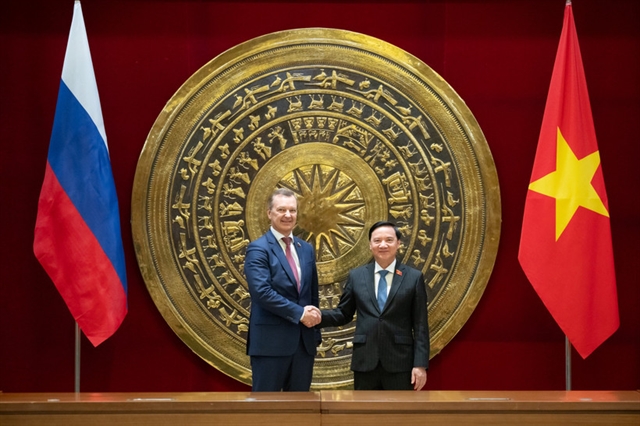 Opinion
Opinion


|
| Workers pack solar panels at Quang Châu Industrial Zone, Bắc Giang Province. — VNA/VNS Photo Danh Lam |
How do you evaluate the development of industrial zones in Bắc Giang Province over the past years, considering the province's consistent high economic growth, particularly given the significant contribution of the industrial sector?
Bắc Giang has witnessed remarkable economic growth in recent years, consistently maintaining a leading position nationwide. This accomplishment is attributed to the efforts of the political system, the close management coordination from all levels, sectors, local authorities and residents. In this context, the industrial sector emerges as a pivotal contributor to the province's economic prosperity.
Especially in 2020, facing challenges posed by the COVID-19 pandemic, Bắc Giang achieved an impressive gross regional domestic product (GRDP) growth rate of 13.02 per cent, topping the national rankings. In the economic structure, the proportion of the industrial sector increased from 7 per cent (in 2000) to over 47 per cent (in 2020), becoming the primary driving force behind the province's economic growth.
Despite the heavy impact of COVID-19 in 2021, the province's GRDP still reached 7.82 per cent, ranking 10th nationwide.
In 2022, the province witnessed an extraordinary economic surge, boasting a growth rate of 19.3 per cent, nearly 2.5 times the national average. This achievement, the highest on record, secured the province's second position nationwide.
The economic structure underwent a significant shift towards increasing the proportion of the industrial sector, with industry and construction accounting for 62.3 per cent, a 4.5 per cent increase; services accounted for 22.8 per cent, a decrease of 2 per cent; and agriculture, forestry and fisheries accounted for 14.9 per cent, a 2.5 per cent decrease compared to 2021.
In 2023, the industrial proportion is projected to experience a robust increase, with the industrial and construction sectors expected to account for 65.8 per cent, an increase of 2.8 per cent; services 21.2 per cent, a 1.2 per cent reduction, while agriculture, forestry and fisheries are estimated to represent 13 per cent, down 1.7 per cent compared to 2022.
The expanded scale of GRDP indicates an estimated annual value of approximately VNĐ181.8 trillion (US$7.51 million), surpassing the planned target by 0.2 per cent (expected to rank twelfth nationwide). The per capita GRDP is expected to reach $3,950, showing a 10 per cent increase and exceeding the planned target by 3 per cent.
Industry has been identified as the main pillar and primary driving force for growth, as well as for the economic restructuring of Bắc Giang Province. How has the province devised an effective plan for developing industrial infrastructure and attracting investments to realise this goal by 2025?
To facilitate the planned and quality development of industrial zones (IZs), the Management Board of Industrial Zones has advised the Provincial People's Committee to issue a plan for establishing industrial zones for the 2022-2025 period. This plan prioritises the establishment of 15 new industrial zones, covering a total planned land area of approximately 835 hectares.
The management board of industrial zones is tasked with zoning plans and detailed planning of the industrial zones, which will be submitted to the Provincial People's Committee for approval according to regulations. This aims to attract investors for the construction and business development of industrial infrastructure in a timely manner.
As of now, the province has 20 IZs, with eight currently in operation, approved and planned by the Provincial People's Committee, covering a total planned land area of nearly 4,600 hectares. There are currently eight new IZs and one expanded IZ for which investors have submitted proposal documents to the Ministry of Planning and Investment for evaluation and submission to the Prime Minister for approval of the investment policy.
Additionally, the province continues to focus on developing technical infrastructure to meet the needs of IZ development, especially in transportation, electricity supply, water supply and social infrastructure to serve the workers in these industrial zones.
How will the management board of industrial zones implement solutions to support businesses and contribute to enhancing the efficiency of the investment attraction process and promoting development in the industrial sector?
First and foremost, the management board will concentrate on significantly improving the investment and business environment – making it favourable, equitable, transparent and user-friendly – to boost investment attraction, foster business development, and enhance the province's competitiveness index. The focal point will be on enhancing leadership capabilities, directing operations, innovating thinking, and resolutely implementing substantial administrative reforms.
Secondly, there will be an intensified effort to attract infrastructure investments for IZs, ensuring a cohesive approach and a readily available land fund to attract further investments.
Thirdly, the proactive and continuous enhancement of the quality of investment promotion activities will be a priority. Focus will be placed on large corporations and enterprises, with appropriate support policies for significant investors. Priority will be given to projects that contribute significantly to the budget, employ fewer workers, use advanced technology, and minimize environmental impact.
Fourthly, there will be an increased focus on State support and management for post-licensing investment activities. This involves monitoring, offering assistance, accelerating the implementation of investment projects, consistently promoting awareness of legal regulations across different sectors, and promptly identifying and collaborating with relevant authorities to inspect, examine and rigorously address any violations of laws relating to investment, construction and environmental protection. — VNS




